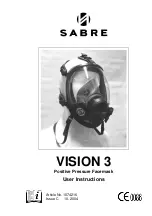
Page 10
AR-G2/AR 2000ex/AR 1500ex Getting Started Guide
Handling Liquid Nitrogen
The ETC uses the cryogenic (low-temperature) agent, liquid nitrogen, for cooling. Because of its low tem-
perature [–195°C (–319°F)], liquid nitrogen will burn the skin. When you work with liquid nitrogen, use
the following precautions:
•
Liquid nitrogen evaporates rapidly at room temperature. Be certain that areas where liquid nitrogen is
used are well ventilated to prevent displacement of oxygen in the air.
•
Wear goggles or a face shield, gloves large enough to be removed easily, and a rubber apron. For extra
protection, wear high-topped, sturdy shoes, and leave your trouser legs outside the tops.
•
Transfer the liquid slowly to prevent thermal shock to the equipment. Use containers that have
satisfactory low-temperature properties. Ensure that closed containers have vents to relieve pressure.
•
The purity of liquid nitrogen decreases as the nitrogen evaporates. If much of the liquid in a container
has evaporated, analyze the remaining liquid before using it for any purpose where high oxygen con-
tent could be dangerous.
•
The oven inner doors have a trough around the bottom of the element assembly for collection of excess
liquid nitrogen. Any excess fluid collected will drain out from the oven at the lower outer edge.
If a person is burned by liquid nitrogen:
1
IMMEDIATELY flood the area (skin or eyes) with large quantities of cool water, then apply cold
compresses.
2
If the skin is blistered or if there is a chance of eye infection, take the person to a doctor IMMEDIATELY.
Chemical Safety
•
Do not use hydrogen or any other explosive gas with the ETC.
•
Use of chlorine gas will damage the instrument.
•
If you are using samples that may emit harmful gases, vent the gases by placing the instrument
near an exhaust.
Usage Instructions
Before connecting the rheometer to auxiliary equipment, you must ensure that you have read the relevant
installation information. Safety of the rheometer may be impaired if the instrument:
•
Shows visible damage
•
Fails to perform the intended measurements
•
Has been badly stored
•
Has been flooded with water
•
Has been subjected to severe transport stresses.
Summary of Contents for AR-G2
Page 1: ...Revision R Issued January 2011 Getting Started Guide AR G2 AR 2000ex AR 1500ex Rheometers...
Page 12: ...Page 12 AR G2 AR 2000ex AR 1500ex Getting Started Guide This page is intentionally blank...
Page 16: ...Page 16 AR G2 AR 2000ex AR 1500ex Getting Started Guide This page is intentionally blank...
Page 54: ...Page 54 AR G2 AR 2000ex AR 1500ex Getting Started Guide This page is intentionally blank...











































